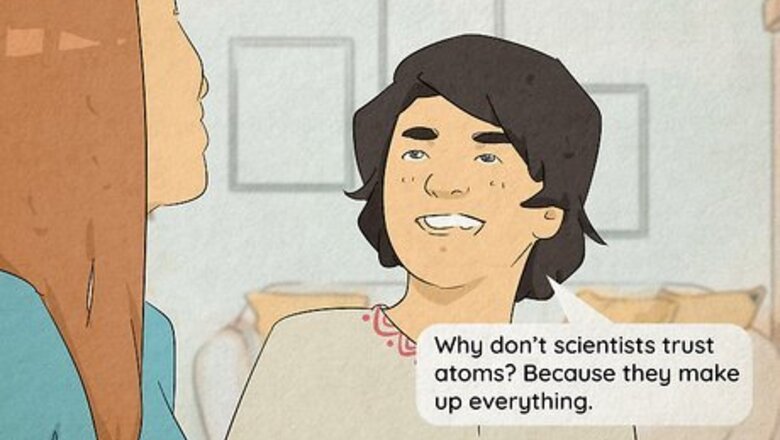
views
Puns

A goofy pun is great—even when it’s so bad it makes your eyes roll. Puns rely on one word or phrase being used two ways at the same time, which is where the joy and humor comes from. Some of the best puns are even intentionally silly, or don’t make sense on a literal level. These jokes aren’t for everyone, but if your audience has an inclination towards humor so bad that it’s good, you’ll have people in stitches! “I named my dog ‘five miles,’ so that I can say ‘I walked five miles today.’” “Jokes about steak are a medium rarely done well.” “This nosy pepper keeps bothering people. It just gets jalapeno business.” “Did you hear about the actor who fell through the floorboards? They’re just going through a stage.” “Why don’t scientists trust atoms? Because they make up everything.”
Observational jokes
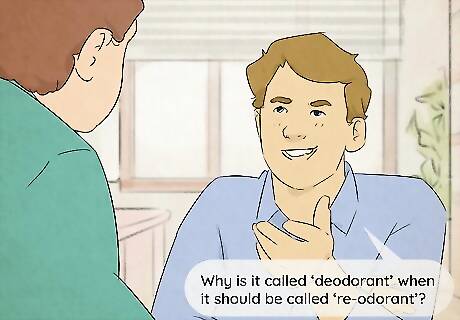
Observational humor is fun if you enjoy pointing out life’s little quirks. This type of comedy is extremely popular, and it’s a common form of joke-telling for stand-up comedians. Observational jokes tend to require some context, but if your audience understands what you’re commenting on, this is a great way to get a laugh. Basically, you find something “normal” and point out something silly or strange about it. “Why is it called ‘deodorant’ when it should be called ‘re-odorant’?” “Why did Michael Jordan have a coach? He’s the best basketball player of all time. What did the coach do? Just yell, ‘Yeah! Keep doing that Mike!’” “People always say they’re ordering food at a restaurant, but really they’re ordering the server.” “Parking attendants always sit in little glass booths; they don’t really attend to anything, do they?”
Absurdist jokes

Absurdist humor is funny because random nonsense is funny. Ever find yourself laughing when someone makes silly noises with their mouth? Ever burst out in tears just because someone said something so confusing you couldn’t make sense of it? Absurd jokes can take a variety of forms, but the main thing is that they’re either totally nonsensical, or kind of come close to making sense but don’t. They tend to only be funny for people who “get it” (or don’t’?), and the delivery is often a big part of making these land. “Does anyone know how to clean syrup off of a wood floor? It’s a serious question, I have syrup all over my floor.” “Why do seagulls fly over the sea? Because if they flew over the bay they’d be bagels, and bagels can’t fly.” “I bought a thesaurus yesterday; unfortunately, I don’t know how to read.” “Did you know that France is actually smaller than every other country combined?” “I saw a fish in the bathroom, and I was just like, ‘Woah. You don’t belong here. Get out of here fish.’”
Sarcastic jokes

Sarcasm is when you say one thing, but you mean the opposite. A lot of people think of sarcasm as a dull form of humor, but a good sarcastic joke can get a serious laugh! These jokes are all about the delivery, so try raising your voice a bit and rolling your eyes while you lean into the punchline. “Just remember, I’m a unique individual. Like everyone else!” “I always tell my employees, don’t think of me as your boss. Think of me as a friend who can fire you.” “Honesty is the best policy. I invented that quote back when I was the president.” “I’m not a sarcastic person. I always say what I mean.”
Knock-knock jokes

They’re a silly classic, but they’re a ton of fun! These jokes are great because everyone knows the format, and the person you’re talking to gets to participate. The structure of these jokes work like this—you say, “Knock knock,” and the other person asks, “Who’s there?” You throw out a name or short phrase, and they repeat it by adding, “who?” The punchline is usually a reversal or pun of some kind. These are really easy to come up with, and they’re a great way to get a chuckle! “Knock, knock.” Who’s there? “Water” Water who? “Water you asking me so many questions for? Let me in already!” “Knock, knock.” Who’s there? “Nobel” Nobel who? “No bell, that’s why I’m knocking.” “Knock, knock.” Who’s there? “Tank.” Tank who? “You’re welcome!” “Knock, knock.” Who’s there? “Control freak.” Control freak who? “Okay, now you say ‘Control freak who?’” “Knock, knock.” Who’s there? “A cow who interrupts people.” A cow who inter— “MOO!”
Chicken crossing the road jokes
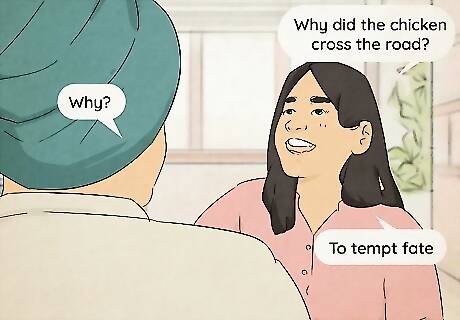
This is another popular format with a lot of room for creativity. Unlike the knock-knock joke, this format is unique because everyone knows the traditional punchline—“to get to the other side.” Since the punchline is already in the back of the audience’s head, you can play with that expectation to make it funny! Feel free to swap out the chicken for another subject or toy with the setup a bit if you want to make it your own. “Why did the chicken cross the road?” Why? “No one knows, but the road is clearly upset about it.” “Why did the chicken cross the road?” Why? “Arrogance. Pure, unadulterated pride.” “Why did the chicken cross the road?” Why? “To tempt fate.” “Why did the cow cross the road?” Why? “Because it wanted to go to the moo-vies.” “Why did the chicken go looking for ghosts?” Why? “To get to the other side.”
A man walks into a bar jokes
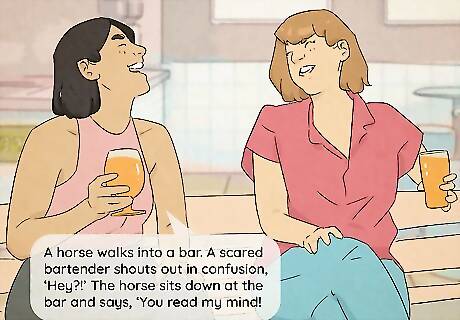
These jokes are fun because they’re silly little stories. You get to paint a picture with your narrative while building up to the punchline, and there are a lot of ways to turn these jokes on their head. The structure is well-known, but the jokes themselves are often very different from one another. These gags tend to do well with an older audience, but they’re definitely a fun way to get a laugh. “A neutron walks into a bar and orders a drink. When they finish it, they say, ‘So, how much do I owe you, bartender?’ The bartender replies, ‘For you, my friend, no charge.’” “A man who goes digging for expensive gems walks into a bar. The bartender shakes his head and asks him to leave. He says, ‘Sorry, we don’t serve miners here.’” “A bear walks into a bar and says, ‘I’ll take a whiskey and…soda.’ The bartender asks, ‘Why the long pause?’ and the bear says, ‘I’m not sure. I was born with them.’” “A horse walks into a bar. A scared bartender shouts out in confusion, ‘Hey?!’ The horse sits down at the bar and says, ‘You read my mind!’”
Light bulb jokes
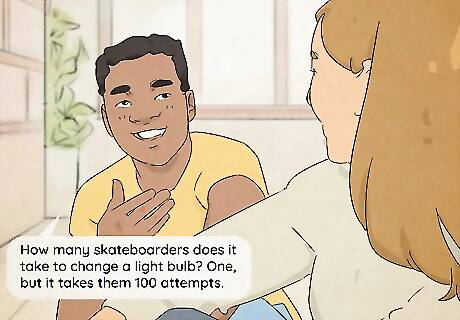
This is a great format if you want a joke that works with a specific audience. While some of these can be kind of insensitive, the most successful “lightbulb” jokes are versions that aren’t putting people down, but playing around with a hobby or job. As a rule of thumb, if you could tell a “How many X does it take to change a light bulb” to a person who happens to be X and they’d actually laugh, you’re in the clear. “How many psychiatrists does it take to change a light bulb? Only one, but the lightbulb has to really want to change.” “How many surrealists does it take to change a light bulb? Three. One to hold the giraffe, one to turn into a flower, and a third to screw the bulb in.” “How many software engineers does it take to change a light bulb? None, that’s a hardware problem.” “How many skateboarders does it take to change a light bulb? One, but it takes them 100 attempts.” “How many politicians does it take to change a light bulb? Two. One to change it, and the other to change it back.”
Tongue twisters

These jokes are usually funny because they sound so silly. They’re really interesting to younger children, who tend to laugh when they try to repeat the punchline back. Still, they’re a fun way for anyone to get a quick giggle or smile. The trick here is to find a contrived reason to put a bunch of similar-sounding words together, and they’re a lot of fun to come up with! “I needed someone to draw realistic dogs for me. Unfortunately, the labradoodle doodle dude will have to do.” “I was worried that my father sold something silly for a living, but it turns out that seldom do dads sell dumb doodads.” “Did you hear about the three friends who drew each other? Andrew drew Ann, Ann drew Drew, and Drew drew Ann drawing Andrew.” “How do you tell the time in Dublin? An Irish wristwatch.” “Microsoft doesn’t have a marketing campaign for their new database software. It turns out that Excel excels at cells, so it sells itself.”
Anti-jokes

Anti-jokes are hilarious precisely because they aren’t jokes. They normally take the structure of a preexisting joke format, like the knock-knock joke, and turn them on their head to make them as unfunny or literal as possible. The humor comes from the audience’s expectation that there will be a punchline, and when there isn’t—at least in a traditional sense—you’ll have people laughing! Try prepping your audience before telling one of these by saying, “Want to hear a joke?” “A bird walks into the dentist’s office. It goes to the front desk and says, ‘Hello, I need the dentist to take a look at this tooth that’s bothering me.’ The secretary says, ‘I’m sorry, we don’t have a bird dentist here.’” “Why can’t a T-Rex clap their hands? Because they’re extinct.” “A priest, a rabbi, and a monk walk into a bar. They have a pleasant time discussing a variety of topics because they’re all good friends.” “What’s the difference between a joke and a rhetorical question?” “Knock, knock.” Who’s there? “To” To who? “No, no, it’s ‘to whom.’ You use ‘who’ when it refers to the subject of a sentence.”


















Comments
0 comment